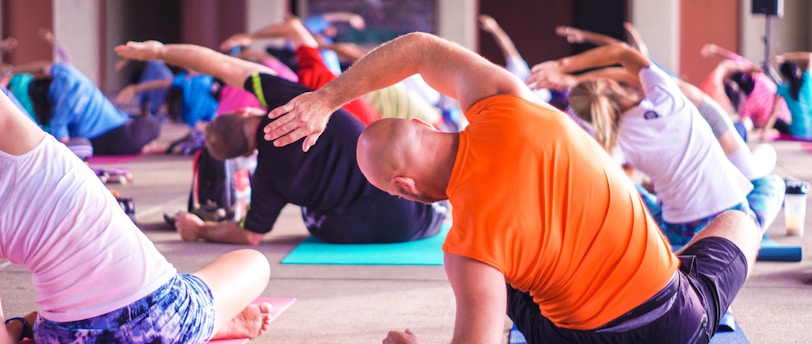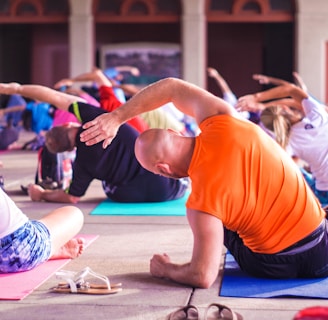What Is Somatic Yoga? Benefits, Techniques, and How to Start
Explore somatic yoga, a practice that blends gentle movements and mindfulness to relieve pain, reduce stress, and improve mobility.
HOW TOEXERCISEYOGA
7/1/20244 min read


What is Somatic Yoga?
Somatic yoga is a gentle yet powerful practice that combines the principles of somatics and yoga to enhance physical, emotional, and mental well-being. By focusing on mindful movement, body awareness, and breath, this approach helps individuals release tension, improve mobility, and reconnect with their inner selves. Unlike traditional yoga, which often emphasizes poses and sequences, somatic yoga prioritizes how movements feel, encouraging exploration and self-discovery:
Somatic yoga combines mindful movement and yoga principles for holistic well-being.
This practice enhances mobility, relieves pain, and reduces stress through gentle, intentional exercises.
Suitable for all ages, somatic yoga supports healing and improves mind-body awareness.
Key benefits include better posture, flexibility, and emotional balance.
Whether you’re seeking relief from chronic pain or looking to deepen your mind-body connection, the practice of somatic yoga is worth trying.
The Origins of Somatic Yoga
The term “somatic” originates from the Greek word soma, meaning “the body as experienced from within.” Somatic practices, including somatic yoga, are rooted in the belief that the body and mind are deeply interconnected. This philosophy has been influenced by somatic pioneers like Thomas Hanna, who developed Hanna Somatic Education, and pioneers in yoga therapy who sought to make traditional yoga practices more accessible and therapeutic.
Somatic yoga evolved as a fusion of these disciplines, blending somatic movement techniques with yoga principles to create a practice focused on mindfulness, awareness, and functional movement.
How Does Somatic Yoga Work?
Somatic yoga integrates gentle movements, breathing exercises, and mental focus to address physical and emotional tension. Practitioners often engage in slow, deliberate movements designed to bring awareness to specific areas of the body. This mindful approach allows individuals to notice patterns of tension or restriction and consciously release them.
Key elements of somatic yoga include:
Mindful Movement: Movements are slow and intentional, encouraging practitioners to focus on the sensations within their bodies.
Breath Awareness: Deep, conscious breathing helps calm the nervous system and enhances the mind-body connection.
Body Scanning: Guided practices often include body scans to bring attention to areas of tension or discomfort.
Restorative Poses: Gentle, supported yoga poses are used to relax and rejuvenate the body.
Unlike fast-paced yoga styles, somatic yoga emphasizes exploration rather than achieving a “perfect” pose. This makes it accessible to people of all ages and fitness levels, including those with chronic pain or limited mobility.
The Benefits of Somatic Yoga
Somatic yoga offers a wide range of physical, mental, and emotional benefits. Here’s how this practice can transform your well-being:
1. Relieves Chronic Pain
Many people turn to somatic yoga to alleviate chronic pain caused by tension, stress, or injuries. By gently retraining the nervous system and releasing habitual tension patterns, somatic yoga helps reduce discomfort and improve mobility.
2. Improves Mobility and Flexibility
Somatic yoga encourages functional movement, helping the body move more efficiently. Over time, this can improve flexibility, coordination, and overall range of motion.
3. Reduces Stress and Anxiety
The mindfulness techniques in somatic yoga calm the nervous system and promote relaxation. Deep breathing and intentional movement help reduce cortisol levels, fostering a sense of peace and emotional balance.
4. Enhances Mind-Body Awareness
Somatic yoga cultivates a deeper understanding of how the body and mind are interconnected. This heightened awareness can lead to better posture, improved alignment, and greater emotional resilience.
5. Supports Healing and Recovery
Whether recovering from an injury or managing a chronic condition, somatic yoga offers a gentle, non-invasive way to restore balance and promote healing.
Who Can Benefit from Somatic Yoga?
Somatic yoga is suitable for everyone, regardless of age, fitness level, or physical condition. This practice can be especially beneficial for:
Individuals with Chronic Pain: Somatic yoga offers relief from conditions such as back pain, neck tension, and joint discomfort.
Athletes and Dancers: The practice enhances body awareness, coordination, and flexibility.
Stress-Prone Individuals: Somatic yoga helps reduce stress and improve emotional well-being.
Beginners: The gentle nature of somatic yoga makes it an excellent entry point for those new to yoga or movement practices.
How to Practice Somatic Yoga
If you’re ready to explore somatic yoga, here are some steps to get started:
Find a Quiet Space: Choose a calm, comfortable area where you can focus without distractions.
Start with Simple Movements: Begin with basic somatic exercises, such as gentle spinal twists or hip circles.
Focus on Sensations: Pay attention to how each movement feels. Notice areas of tension or resistance and adjust your movements as needed.
Incorporate Breathwork: Practice deep, diaphragmatic breathing to enhance relaxation and body awareness.
Follow Guided Sessions: Consider using online videos or attending a class led by a certified somatic yoga instructor.
Common Somatic Yoga Exercises
Here are a few exercises to try:
1. Pelvic Tilts
Lie on your back with your knees bent and feet flat on the floor.
Slowly tilt your pelvis forward and backward, noticing the sensations in your lower back and hips.
2. Shoulder Rolls
Sit or stand comfortably.
Gently roll your shoulders forward, upward, backward, and downward in a circular motion.
3. Cat-Cow Stretch
Begin on your hands and knees in a tabletop position.
Alternate between arching your back (cow pose) and rounding it (cat pose), moving slowly and mindfully.
4. Leg Slides
Lie on your back with your legs extended.
Slide one leg up and down the mat, paying attention to the movement in your hips and lower back.
Incorporating Somatic Yoga into Daily Life
To fully experience the benefits of somatic yoga, try integrating it into your daily routine. Dedicate 10–15 minutes each day to mindful movement and breathwork. You can also use somatic techniques during stressful moments to ground yourself and release tension.
Somatic yoga is more than just a physical practice—it’s a holistic approach to well-being. By cultivating awareness and releasing tension, you can transform your relationship with your body and mind, paving the way for greater health and vitality.
Resounding Harmony
Your journey to holistic health starts here
sign up
© 2024. All rights reserved.
Website by Creative Web Design Lab